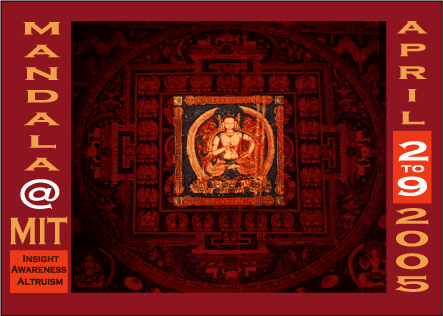
|
I respectfully urge you who study the mystery,
don't pass your days and nights in vain.
Sekito Kisen, Sandokai

The Vajrasattva Sand Mandala
For Insight, Awareness and Altruism

Simmons Hall, MIT
229 Vassar St., Cambridge, MA
April 2-9, 2005
[ Click
here to view photographs ]
The Tibetan culture is one of the most ancient of our planet and it is highly endangered. Among the Tibetan arts, sand Mandala or painting with colored sand, ranks as one of the most unique and exquisite. The Mandala is an ancient art form of Tibetan Buddhism. It is constructed as a vehicle to generate compassion, realize the impermanence of reality, and a social/cosmic healing of the environment.
Millions of grains of colored sand are painstakingly laid into place on a flat platform over a period of several days, forming an intricate diagram of the enlightened mind and the ideal world. The most common substance used is colored sand, which is ground from stone. When the sand Mandala is completed, to symbolize the impermanence of all that exists, the colored sands are swept up and poured into a nearby river or stream where the waters carry the healing energies throughout the world.
Construction of the Sand Mandala begins on April 2, 2005.
Construction of the Sand Mandala will be led by Lama Dhondup of the Gyuto Tantric College, India and Ven. Tenzin Priyadarshi.
Public Viewing Hours:
April 2 - April 7, 2005: 10:30am - 2:00pm and 4:00pm - 7:30pm
April 8, 2005: 10:00am - 2:00pm and 4:00pm - 5:30pm
April 9, 2005: 10:00am until the dissolution of the Sand Mandala
(All are welcome to join the Dissolution Ceremony of the Sand Mandala)
| Event |
Time/Place |
Opening Reception and Prayers
Performance by Simmons Orchestra
Prayers by Buddhist Monks and Nuns
Tibetan Long Horn Performance (Penpa Tsering)
Refreshments to follow. |
Saturday, April 2 at 7:00pm
Simmons Hall |
Tsa Tsa Painting Workshop
Registration Cost: $15
For registration send e-mail (with your address and telephone number) to upaya@prajnopaya.org
The ancient meditative practice of Tibetan Tsa Tsa painting is a sacred art that helps promote patience, focus and concentration. This meaningful and satisfying activity can also help open one's heart and mind to the positive energy of the deity being painted. In the case of the Solitary Vajrasattva, who represents the altruistic healing power in the universe, painting the image helps us become more receptive to that energy, and allows us to become aware of the healing potential within ourselves. |
Sunday, April 3 at 1:00pm
Simmons Hall |
Screening of Silent Water
Talk by the Lead Actress Ms. Shilpa Shukla
Winner of the Best Film Award 2004 at the Locarno International Film Festival, "Khamosh Pani" (Silent Water) has captivated its audience in the telling story of a young religious fanatic and the women in his life. |
TBA |
Meditation and Teachings on Vajrasattva
By Ven. Tenzin Priyadarshi |
Thursday, April 7 at 7:00pm
Simmons Hall |
Awakening Bliss, Generating Compassion
A Talk by Robert Thurman
Jey Tsong Khapa Professor of Buddhism, Columbia University
Tibetan Flute Performance by Penpa Tsering
Limited tickets available for not-MIT members: $15
Tickets go on sale at MIT (Student Center and Infinite Corridor) on March 15, 2005.
All advance tickets to the talk by Robert Thurman are sold out. There will be a few tickets available at the door of Simmons Hall before the talk. We suggest that you arrive early to take advantage of this.
For more information contact upaya@prajnopaya.org
 Named as one of Time Magazine's 25 Most Influential People of 1997 Robert A. F. Thurman, PhD., has been a college professor and writer for 30 years, and holds the first endowed chair in Indo-Tibetan Buddhist Studies in America (Jey Tsong Khapa Chair, Columbia University). He was the first Western Tibetan monk, a student and for over 35 years a friend of His Holiness the Dalai Lama. He is the author of several books, including Inner Revolution and Essential Tibetan Buddhism and acknowledged as a key figure in American Buddhism...Thurman is also known as the father of actress Uma Thurman. Named as one of Time Magazine's 25 Most Influential People of 1997 Robert A. F. Thurman, PhD., has been a college professor and writer for 30 years, and holds the first endowed chair in Indo-Tibetan Buddhist Studies in America (Jey Tsong Khapa Chair, Columbia University). He was the first Western Tibetan monk, a student and for over 35 years a friend of His Holiness the Dalai Lama. He is the author of several books, including Inner Revolution and Essential Tibetan Buddhism and acknowledged as a key figure in American Buddhism...Thurman is also known as the father of actress Uma Thurman.
 Thurman is not only a scholar, but a champion of the preservation of Tibetan culture. In 1987, he and actor Richard Gere founded New York City's Tibet House, a nonprofit institution devoted to preserving the living culture of Tibet. Thurman writes, "What I have learned from these people [Tibetans] has forever changed my life, and I believe their culture contains an inner science particularly relevant to the difficult time in which we live. My desire is to share some of the profound hope for our future that they have shared with me." Thurman is not only a scholar, but a champion of the preservation of Tibetan culture. In 1987, he and actor Richard Gere founded New York City's Tibet House, a nonprofit institution devoted to preserving the living culture of Tibet. Thurman writes, "What I have learned from these people [Tibetans] has forever changed my life, and I believe their culture contains an inner science particularly relevant to the difficult time in which we live. My desire is to share some of the profound hope for our future that they have shared with me."
(This talk will be followed by a book signing by the author and reception) |
Friday, April 8 at 7:00pm
Simmons Hall |
Make Your Own Mandala: A Workshop for Kids
(Children 5 and up must be accompanied by an adult)
For registration send e-mail to upaya@prajnopaya.org
|
Saturday, April 9 from 11am to 2pm
Simmons Hall |
| Dissolution of the Sand Mandala |
Saturday, April 9 at 3:00pm
Simmons Hall |
Sponsored By:
MIT-Prajnopaya, The Buddhist Community at MIT
Bill (1956) and Betsy Leitch Endowment
Simmons Hall
Co-Sponsored By:
Office of the Dean of Student Life
MIT Funds
Council for the Arts at MIT
The Prajnopaya Foundation
|

Named as one of Time Magazine's 25 Most Influential People of 1997 Robert A. F. Thurman, PhD., has been a college professor and writer for 30 years, and holds the first endowed chair in Indo-Tibetan Buddhist Studies in America (Jey Tsong Khapa Chair, Columbia University). He was the first Western Tibetan monk, a student and for over 35 years a friend of His Holiness the Dalai Lama. He is the author of several books, including Inner Revolution and Essential Tibetan Buddhism and acknowledged as a key figure in American Buddhism...Thurman is also known as the father of actress Uma Thurman.
Thurman is not only a scholar, but a champion of the preservation of Tibetan culture. In 1987, he and actor Richard Gere founded New York City's Tibet House, a nonprofit institution devoted to preserving the living culture of Tibet. Thurman writes, "What I have learned from these people [Tibetans] has forever changed my life, and I believe their culture contains an inner science particularly relevant to the difficult time in which we live. My desire is to share some of the profound hope for our future that they have shared with me."
